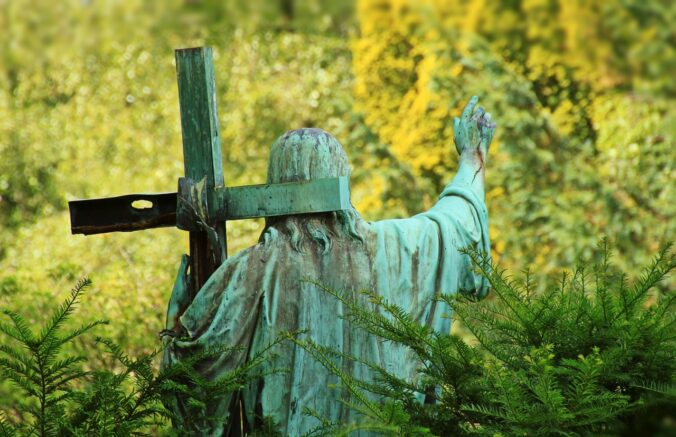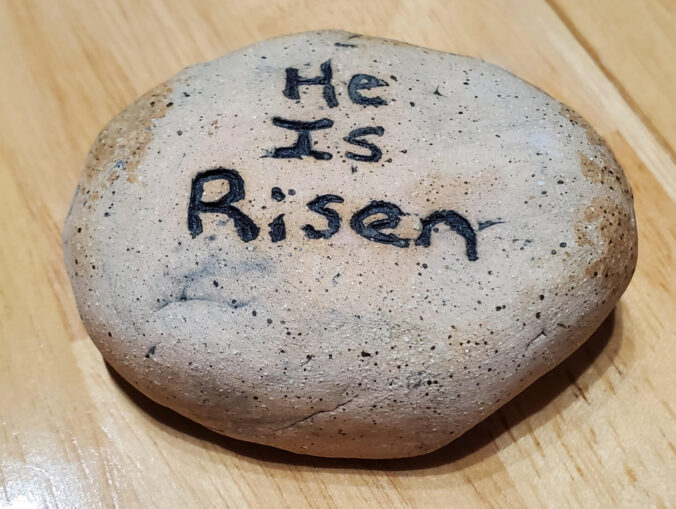I have been reading again the Book of Revelation, which was written by John, the beloved apostle and friend of Jesus. This Book recounts John’s vision of Heaven and the second coming of Christ — portraying the destruction of the world as we know it, and the ultimate triumph of good over evil.
The Book of Revelation is rich and varied in content. Some elements of John’s story read much like a fantasy adventure! For instance, John describes seeing creatures in Heaven that are both awe-inspiring and frightening. There are the four living creatures, gathered all around and on each side of the throne of Heaven, ceaselessly guarding and worshiping this holy and sacred place:
“Full of eyes in front and behind: the first living creature like a lion, the second living creature like an ox, the third living creature with the face of a man, and the fourth living creature like a flying eagle. And the four living creatures, each of them with six wings, are full of eyes all round and within, and day and night they never cease to sing, ‘Holy, holy, holy, is the Lord God Almighty, who was and is and is to come!'” Revelation 4: 6-8
There is the dragon waiting to devour the child of “a woman clothed with the sun, with the moon under her feet, and on her head a crown of twelve stars.” (Revelation 12: 1) The woman is in labor and about to deliver a child:
“Behold, a great red dragon, with seven heads and ten horns, and seven diadems upon his heads. His tail swept down a third of the stars of heaven, and cast them to the earth. And the dragon stood before the woman who was about to bear a child, that he might devour her child when she brought it forth.” Revelation 12: 3-4
At one point, a war breaks out in Heaven, as St. Michael the Archangel and his angels fight the dragon that is threatening the woman. (Revelation 12: 7-12) Much of the middle chapters of Revelation — in particular, Chapters 6, 8-9, 13, and 15-18 — recount various devastations and plagues being released upon the earth, as God empties His final wrath and deep sorrow for the sins of humankind.
Other elements of the text are simple and straightforward. John opens by plainly telling us that he is a “witness to the Word of God and to the testimony of Jesus Christ.” (Revelation 1: 2) John states that he has seen a vision of the Risen Jesus and that he has been instructed by Jesus to write down what he has heard and seen. (Revelation 1: 9-20)
John first shares a message from Jesus, to the seven churches of Asia Minor. (Revelation Chapters 2 and 3) It is both amazing and heartbreaking to read and think about what Jesus is saying to the Churches, through John. Each of the seven messages appear fully in red ink, denoting that these are the words of Jesus Himself. His words are timeless — as relevant to us today as they were to the early followers of the Church.
Every single word of the Bible is inspired by God, so that we may be equipped for good lives. (2 Timothy 3: 16-17) Because of this, we can deduce that even the placement of various Books in the Bible is inspired by God. So we should not take lightly that God closes the Bible with a final warning that the world as we know it will end some day, and that a final judgment for all of us is certain.
Nor should we take lightly these final words of guidance, from the Risen Jesus, about how to persevere and grow as believers. With an uncompromising Love, Jesus is preparing us for the final judgment of God the Father.
Jesus first addresses the Church in Ephesus, and while it seems that the followers there are working hard to keep the faith, Jesus warns them to not become complacent in their love for Him:
“‘But I have this against you, that you have abandoned the love you had at first.'” Revelation 2: 4
A message to the Church in Pergamum warns against becoming complacent or numb to the danger of false teachings:
“‘You have some there who hold the teaching of Balaam, who taught Balak to put a stumbling block before the sons of Israel, that they might eat food sacrificed to idols and practice immorality. So you also have some who hold the teaching of the Nicolaitans. Repent then. If not, I will come to you soon and war against them with the sword of My mouth.'” Revelation 2: 14-16
To the Church of Thyatira, Jesus warns against the community’s tolerance of a prophetess who is teaching and encouraging immorality — reminding all of us to guard our minds and hearts against a loss of the awareness of good and evil:
“‘Behold, I will throw her on a sickbed, and those who commit adultery with her I will throw into great tribulation, unless they repent of her doings; and I will strike her children dead … And all the Churches shall know that I am He who searches mind and heart, and I will give to each of you as your works deserve.'” Revelation 2: 22-23
To the Church in Sardis, Jesus urges His followers to avoid complacency and pride:
“‘I know your works; you have the name [or public perception] of being alive [in your faith], and you are dead. Awake, and strengthen what remains and is on the point of death, for I have not found your works perfect in the sight of My God. Remember then what you have received and heard; keep that, and repent. If you will not awake, I will come like a thief and you will not know at what hour I will come upon you.'” Revelation 3: 1-3
There are many other meaningful words of counsel in these messages to the Churches. Chapters 2 and 3 are worth reading over and over. I am focusing here on Jesus’ warning to not become complacent or prideful in our love for Him.
Complacency and pride are dangerous things, when it comes to our faith. And unfortunately, these things seem to go hand-in-hand:
I’m good with God. I don’t need to spend so much time studying the Bible …
I don’t need to spend time alone with Him every day; God knows I love Him …
I’ve been so busy with work and the kids. I don’t think God will mind if I miss Mass …
My life is really starting to turn around. I don’t need to wait for guidance from Jesus about what to do next. I’ve got this …
I know I shouldn’t do this or that, or hang out so much with these friends, but it’s fun to just let go and forget about life every now and then. I’ll worry about tomorrow, tomorrow!
Do any of these words sound as familiar to you as they do to me?
The problem with complacency and pride is that when we open the door to these behaviors, they begin to grow and take root in our hearts. If we’re not careful, they grow like weeds, choking out our desire to continue learning and growing in our relationship with God.
Pride and slothfulness (or complacency) are two of the deadly sins. C.S. Lewis famously described pride as “the anti-God.” And I am guessing you are familiar with this Proverb — “Pride goes before destruction, and a haughty spirit before a fall.” (Proverbs 16: 18)
Saint Thomas Aquinas aptly described complacency as the aimless “tendency to wander.” Within this context, complacency is a lukewarm approach to living life with Jesus. In His message to the Church of La-odicea, Jesus does not mince words about what will happen to those of us who are lukewarm in our faith:
“‘I know your works: you are neither cold nor hot. Would that you were cold or hold! So, because you are lukewarm, and neither cold nor hot, I will spew you out of My mouth.'” Revelation 3: 15-16
These are strong words. Whenever we feel this emotion from Jesus, we know that He is really wanting us to focus on His words. He loves us so much. Jesus knows how easy it is for us to become complacent … and to let things slide a little. He observes that our egos are constantly at work, comparing and assimilating — and assuring us that we have things “all figured out.”
In the opening chapters of Revelation, Jesus is plainly warning us to avoid pride and complacency. He is calling us to reflect on how we are living our lives, and to be honest about where we can make some improvements.
It matters that we try to be a little bit better each day. As we look back over the years of our lives, it matters that we can see how we have grown in our faith.
Jesus is with us and wanting to help us:
“‘Fear not, I am the first and the last, and the Living One; I died, and behold I am alive for evermore, and I have the keys of Death and Hades.'” Revelation 1: 17-18
His Words in Revelation are a gift. Yes, Jesus is telling us that the world as we know it will pass away, through His Second Coming; and that there will be a final judgment. These are uncomfortable truths, perhaps.
But Jesus is also telling us how much He wants us with Him, for all eternity.
Let your minds and hearts take in the words and images shared in this final book of the Bible. John is offering us a view of the uncompromising Love of Jesus and His unending fight for our souls.
Oh Jesus, our King of Love, hold us close in Your arms. Prune from our hearts and minds the seeds of pride and complacency; replacing them with the seeds of humility and hope and perseverance. Help us, Jesus, to return again and again to You. Come, Holy Spirit; fill our minds and hearts with a distinct awareness of what is good and what is evil. Draw us, Holy Spirit, to all that is good and holy. Oh God, our Father, You alone are the source of all Love and Wisdom and Counsel. Help us to live each day aligned with Your most good and holy desires for our lives, so that we may work out our salvation. In Jesus’ name, Amen.










Recent Comments